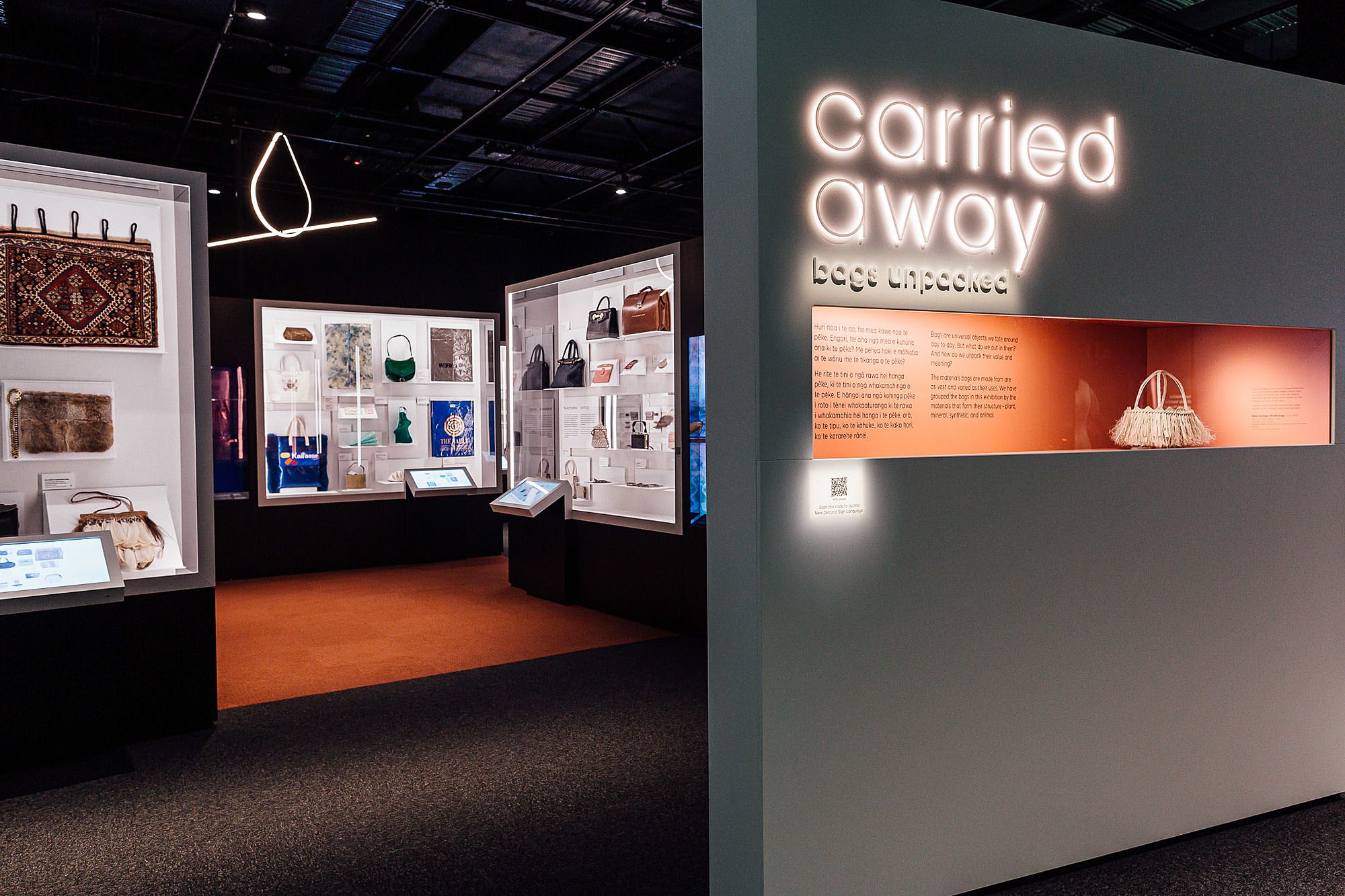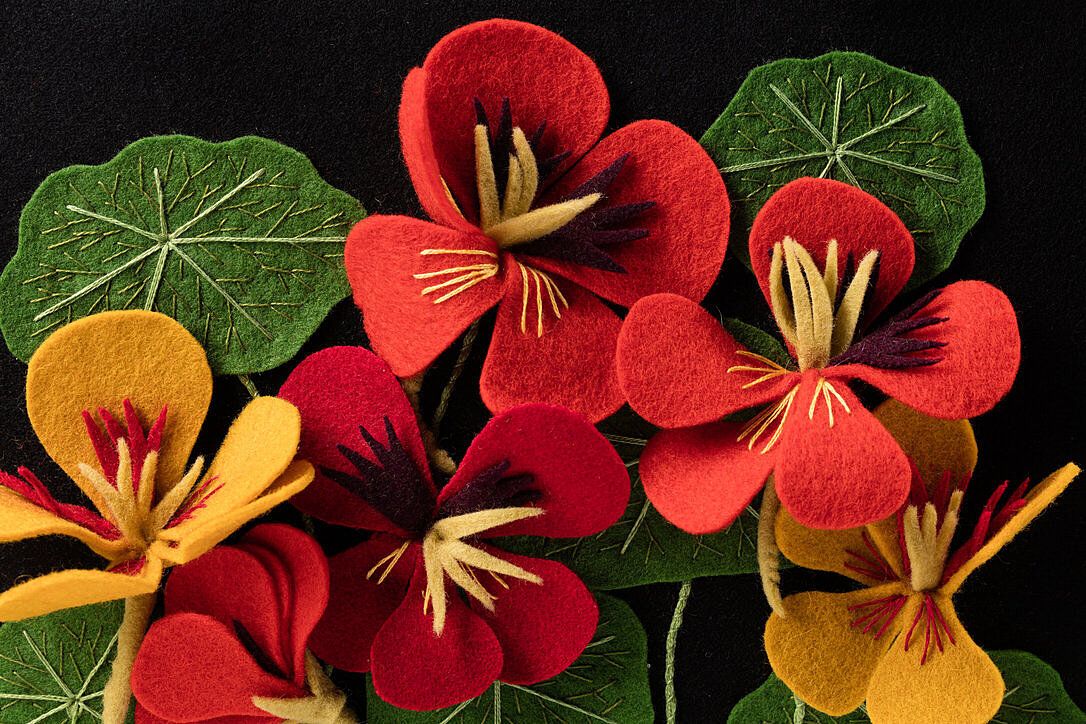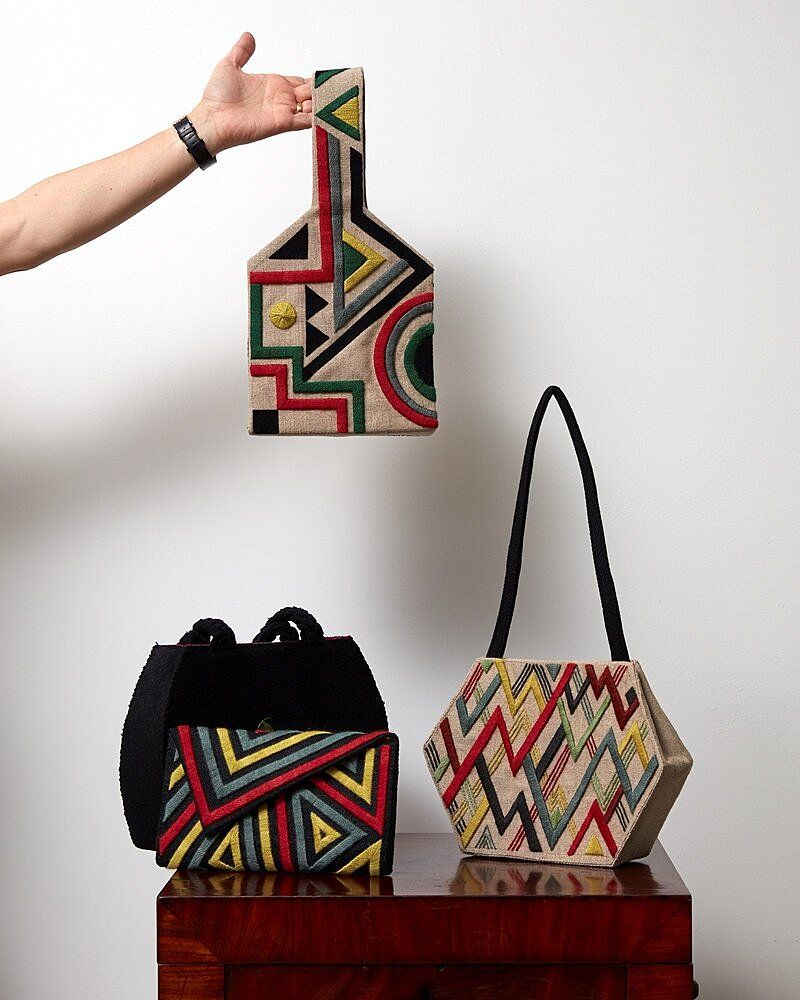A Heart to Heart with Bags
Grace Lai on the multi-hyphenate bag and a kōrero with designer–maker Vita Cochran.
I’m confident, I know what I want, a bottle of milk – easy, it’s an in-and-out job. That is until I get seduced by that tower of fresh avocados and subsequently take a ‘short cut’ down the confectionary aisle. Suddenly my one-item trip to the supermarket turns into a juggling act as I try to balance rolling produce while keeping a good grip on a packet of biscuits. I flood with relief as I reach the cashier and release my provisions… a momentary victory as they make their way to the end of the black conveyor belt, each beep counting down my decision to buy a paper bag or stuff as much as I can into my pockets (if I have pockets) to take them home. I really should have just brought my reusable bag, a sentiment that many may have had since supermarkets in Aotearoa made the environmentally conscious decision to ban single-use plastic bags. Although the verdict is still out on the initiative’s benefit for the environment, there has been a direct impact on consumer behaviour.
The bag has resurfaced as an essential tool in our daily lives.
An overly obvious statement, perhaps, although equally one that can be dismissed as an exaggeration. Bags are ubiquitous; many tout a tote to carry towels and sunscreen to the beach or a brimming backpack of notebooks and stationery to school. Lawyers (at least the ones I see on television) carry the all-important briefcase with mysterious contents. Yet despite their various functions, bags have gained a bad reputation. Some deem them baggage for maximalists,1 others think they are unnecessary when we have pockets, and a fair few think bags are ridiculous extravagances for those with too much money or who care too much about fashion.
Bags are ubiquitous; many tout a tote to carry towels to the beach or a brimming backpack of notebooks to school
It is not hard to see how the latter opinion has formed, when handbags have featured in less-than-favourable headlines in recent times. In 2019, Stuff reported on that Jacquemus bag in an article titled ‘The stupidly tiny handbag that's now in fashion’, which led the current trend in 2021 for micro bags that a Guardian reporter called out in a review headed ‘Perfectly formed – and completely useless.’ It is not just impractical designs that critics have a gripe about; it is the sky-high price tags that often accompany handbags that, to some, merely function as a pretty but useless accessory.
In 2017, the Guardian reported an Hermès Birkin bag that bagged (pun intended and begging to be used) a world record for the highest price fetched for a handbag sold at a public auction. Other media outlets like Fashionista claim that the £279,000 closing bid is “absurd”. At the same time, the BBC expressed their disbelief by comparing the price of the handbag with that of an average house in the United Kingdom. Buried within some of these articles are attempts to validate the monetary value of the handbag, not just as a frivolous trinket but as a solid investment or an example of craftsmanship with a lineage. However, none seem credible or substantial enough to cover up the underlying message, that expensive handbags are a covetable collectible for the rich and famous, a game that only a few can participate in.
A bag of any other name works just as well – backpack, bilum or bokjumeoni
Today, the bag has become synonymous with the worst assumptions about the fashion industry, exclusivity and expense, while remaining one of the most accessible and universally owned objects we have today. The mixed reactions are in part due to the truly multi-hyphenate nature of a carrier almost everyone owns, in one shape or another, that comes with its own lists of pros and cons, that gets jumbled up together under the mother umbrella term: bag. More importantly, perhaps, is that although a bag of any other name works just as well – backpack, bilum (Papua New Guinean string bag) or bokjumeoni (a drawstring silk or cotton pouch embroidered with auspicious symbols) all carry things for us so we can remain hands free – there is one bag that has overshadowed them all: the handbag.
This relatively new member of the bag family arose in Victorian times as a receptacle for women to carry what little possessions they had in public, when decorum removed pockets from women’s dress. According to attitudes of the time, women had too many bulges to require an additional. Today, those who wear women’s clothes bear this legacy of either no pockets or, worse, decorative pockets. As a result, it seems that bags have become solely for the ‘ladies’, no ‘real man’ would dare touch one with a ten-foot pole. This popular perception peaked in the 90s and is captured in the Friends episode ‘The One With Joey’s Bag’, where Joey gets mocked as ‘girly’ for carrying a bag around, even though he tries to rebrand it as a ‘man bag’.
There are cultures that have bags that have never been gendered the way the handbag is
Perceptions are changing on gendered fashion. A New York Times article from November this year titled ‘Goodbye to Murse and Hello to Bag for All’ claims that social rules have relaxed around men carrying bags and backs this up with historical reference, saying that it has been the norm in the past. However, by focusing the article on the liberation of menswear the article misses the important point that gendered fashion, like gender, was a made-up construct to begin with and that the use of ‘man’ as a prefix has harmful impacts not just on women but on the stereotypes of men, and completely disregards those who identify outside of them.
Furthermore, beyond history, there were and are cultures that have bags that have never been gendered the way the handbag is. Exhibitions like Le Cas Du Sac by the Musèe des Arts Dècoratifs, Paris, in 2012 and Carried Away: Bags Unpacked by Tāmaki Paenga Hira Auckland War Memorial Museum in 2019 traced the bag beyond Western gendered history and dug deeper to unpack its significance by exploring the breadth and depth of bags as vessels and tools for humankind. The Victoria and Albert Museum joined the conversation with their exhibition Bags: Inside Out in December 2020, no to mention the museums dedicated to bags, like the recently closed Tassenmuseum Amsterdam, or other institutions who have looked at bags that do not resemble the ones we’re familiar with in the Western world.
Carried Away, 2019, Tāmaki Paenga Hira Auckland War Memorial Museum. Image courtesy of Auckland Museum
To truly appreciate the bag, we have to look beyond the handbag, the flashy logo or trendy design and above all the price tag, and take a look inside. What is externally projected by a bag – perhaps social status and value or style – is equally matched by what it contains; a vessel carrying not just cards and phones or important keepsakes, but our stories and whakapapa.
In her essay ‘The Carrier Bag Theory of Fiction’, Ursula Le Guin retells human history, often understood as a violent hunt for survival. She does this by refocusing on the empty vessel that enabled early humans to carry more than they could in their hands and gather food. She maintains that rather than the spear, it is the receptacle, the carrier bag, sling, shell or gourd, that was the earliest human tool. She writes, “before the tool that forces energy outwards, we made the tool that brings energy home … home being another, larger kind of pouch or bag, a container for people.” Taking this line of thought further, bodies are vessels, some with an additional womb that can carry life. For Le Guin, the novel is also a vessel, a bag of words, and as such should take its natural form, which departs from the tradition of linear time and history and makes room for contradictions and parallels. This is a concept internalised in the practice of Sydney-based Aotearoa designer–maker Vita Cochran, who works between and around several categories of the bag, while continually stitching in and re-stitching traditions as well as personal stories.
Vita is a champion of continuing traditional crafts, many of which were passed down by her grandmother
Vita creates lovingly handmade objects, each one a small act of dedicating time and attention to the process of making as well as meditating on the object itself. I came to know Vita when curating Carried Away: Bags Unpacked. The exhibition featured two of her bags from the Museum’s collection – a delightful handbag featuring felt nasturtiums and another formed from discarded pairs of gloves. Back then, our conversations centred around materials and techniques. Vita advocates for reusing materials and sources secondhand where she can, and is a champion of continuing traditional crafts, many of which were passed down by her grandmother.
Since then, each time Vita dropped a new creation I would rush to not just see but touch and hold it, because, besides her characteristic use of a compelling rich tonal palette, an alluring tactility is a signature part of her work.Naturally, I was delighted to hear from Anna that she would be showcasing 40 bags in her show An Anthology of Bags at Anna Miles Gallery, and could not wait to see the new works. However, with changing alert levels, I settled for the next best thing, a photo preview of her works and an opportunity to talk to Vita about all things bags.
Vita Cochran, Nasturtium Bag, 2016. Image courtesy of Auckland Museum
Vita Cochran, Nasturtium Bag (Detail), 2016. Image courtesy of Auckland Museum
I have never visited Vita’s workroom, yet when we sit down for our virtual chat I am struck by how familiar it looks. Backed by an expansive shelf, Vita is surrounded by the colourful fabrics and patterns I associate with her work. A colourful handbag stitched all over with buttons, complete with a string of buttons that makes up its handle, perches primly next to a reclining tote embroidered with bright red and forest green and featuring cool blue straps (a new piece that will be going on show). Both pieces are neighbours to piles and rolls of cut-up fabric waiting to take their new form. Moving on from pleasantries and Covid-19 chats, we dive right into her collection of bags.
Over the screen, Vita brings up this tiny handbag with a smooth, hard face jutting out in dramatic angles and shiny silver hardware. Vita acknowledges it isn’t all that practical but loves it for how sculptural it is, almost resembling a vintage iron. She delights that it is a challenge to wear a bag you have to accommodate. Then there is the story of a bag she no longer owns but still remembers. An intricate Art Deco cordé, a bag made with cord embroidery, not in the usual shades of black, navy or brown but green, gold and blue. She carried it around everywhere as a teenager; it was her pencil case, her going-out bag, her little bag within a bigger bag.
It all started after a chance encounter with a felt bag she came across in an op shop in 2000
Vita remembers everything about this bag, including the circumstance in which it was lost to her – stolen from the front seat of an unlocked car on Cuba Street. She still keeps an eye out for it, hoping to one day be reunited with this bag she loves. (If you have sighted a bag of the above description, I am sure Vita would appreciate any leads.) These two stories of bags past and present in Vita’s collection reflect her connection to bags, tactile objects meant to be kept close that are deeply personal.
It all started after a chance encounter with a felt bag she came across in an op shop in 2000. A modest, skilfully handmade but not professional, 1930s-style handbag boasting a cluster of floral appliqués that intrigued Cochran enough for her to try making felt-flower bags. At first, they took on a soft body with whimsical flowers from her imagination. She revisited this idea with a series of six bags titled Common Flowers in 2016. This time the handbags took on a studier and more uniform body that almost resembles a mid-century flat vase, a serendipitous coincidence, perhaps, as each one features a near-botanical rendition of a flower familiar to gardens in Aotearoa, such as geraniums, hydrangeas and the nasturtiums mentioned above.
Vita Cochran, Rope Bag (Detail), 2021. Image courtesy of Anna Miles Gallery
Other bags followed, including a rope bag that began as a play with appliqué before percolating into a tote. The rope applied as surface treatment also became the handle, decoration becoming functional. This revisiting of patterns and remaking old designs is a part of Vita’s practice, echoing her preference for found material and evasion of fashion’s carnivorous appetite for the new. This is the central premise for An Anthology of Bags – a nod to Le Guin’s notion of a story, or in this case a visual exhibition, as interwoven bits gathered in one vessel.
Each of the 50 bags going to the show has been remade from a pattern from Vita’s archive, which she was looking through at the start of the pandemic. Though there were a few she didn’t like anymore and some whose design she wanted to take further, Vita was surprised and happy to find that she still loved most of her older designs. It got her wondering what they would look like all gathered in one room, whether they would showcase how an idea evolved and generated links. You’ll have to wait a few weeks to make your own conclusions when you get to see the bags in person (although Anna Miles has kindly allowed me to share a few sneak peeks).
Vita Cochrane, Group of sampler bags. Image Courtesy of Anna Miles Gallery
From what I have seen so far in pixel form, I think it is evident that the show reflects the cyclical return to materials and forms. Each iteration further emphasises the considered designs of Vita’s works. Zips meander into abstract shapes, a nod to Vita’s love of modernist paintings. There is a fun little pouch called Otto, with arms, legs and a wee cheeky smile that is just so endearing I want to carry it with me everywhere. Bargello embroidery takes a legacy of patience and skilled stitching to create a wave of sumptuous surface pattern, though each coloured peak also informs the shape of its host, including a lovely moment when they match up to the loop of the handle or on the side of the body. A giant patchwork bag is closed by a black rope snaking around its border, and opens up to become a picnic blanket – a two-in-one that is most apt in Tāmaki Makaurau right now, where we need to socialise outside. The works in An Anthology of Bags are a personal journey of return and reinvention woven into a larger narrative of the ever-evolving forms of bags throughout cultures and histories.
Vita Cochran, Picnic Bag (Opened), 2021. Image Courtesy of Anna Miles Gallery
The truth is all the rumours you’ve heard about the bag are true, but what has remained consistent is that its functions are defined by its owner. From bilum and kete, pouches to pockets, inrō (a small portable case worn on the girdle) to bokjumeoni, and now the micro and unisex bags designed to neutralise the gendered fashion that has dominated the market, bags throughout history have come in many shapes and sizes, colours and materials. Some will be passed down to grandchildren; others will only claim their five minutes of fame. They might carry diapers for new parents, forgotten lunchboxes for students, techniques passed down from our elders, or sometimes nothing at all except the image their owner wishes to present in this world. Bags, like many objects, are vessels that carry not just the material but the immaterial; social meaning and values. These shape how they are viewed and, in turn, shape society.
1 Those who believe ‘more is more’ and have a preference for excess.
2 I want to acknowledge that I am predominantly speaking about bags within a Western tradition and history.
3 Christopher Todd Matthews, “Form and Deformity: The Trouble with Victorian Pockets,” Victorian Studies 52, no. 4 (2010): 561–590.







